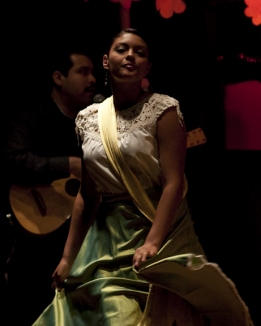Artists’ need for affordable housing and spaces appropriate for making art was identified in the Investing in Creativity report as a particularly urgent problem. LINC’s earliest research project was a partnership with Community Partners Consultants and the Local Initiatives Support Corporation (LISC), one of the largest funders of community development in the country, to explore whether and how LISC local affiliates were investing in artist spaces. The research report revealed that LISC had funded 11 new artist spaces, generating more than 400,000 square feet of artist workspace that attracted over $40 million in additional public and private funding.*The extent of this work showed that local community development corporations could see the powerful connections between artistic production and effective community development. At the same time, the Massachusetts Cultural Council, a Creative Communities partner, took up the issue of space in their local work and quickly began generating information on effective ways to integrate artist space into community development efforts there.
The results of this field-based work, combined with additional research commissioned from the Urban Institute specific to artist space development, reinforced the lessons coming out of LINC’s Artography program. It became clear that cultural organizations with stable access to space behave differently than those for whom space is an issue. This is particularly true for small and mid-sized organizations and organizations rooted in communities of color. Space-rooted organizations can take more risks because they control the use of their facilities, and the spaces of culturally-specific organizations serve as community anchors that promote cultural equity.
Through its various space-related efforts, LINC recognized that an opportunity was emerging to reframe discussions of artist space development—moving it beyond the concerns of individual organizations and individual artists to a broader context involving community development, cultural equity, transmission of cultural heritage, and the integral role of artists and arts organizations in the life of every community. LINC proceeded to develop two new funding opportunities that would propel that reframing: the MetLife Foundation Innovative Space Awards (ISAs) and the Ford Foundation Space for Change Planning and Pre-Development Grants. Both grants included a suite of complementary supports—including the commission of relevant research, facilitation of peer learning, and rigorous technical assistance.
In 2009, with support from MetLife Foundation, LINC invited applications to its Innovative Space Awards, a competitive national funding program designed to highlight the role that affordable artist space projects play in community revitalization and community development. LINC collaborated with MIT’s Department of Urban Studies & Planning to develop a framework for identifying a broad cross-section of potential award recipients. In two rounds of grantmaking, LINC recognized 12 organizations that reflected the wide spectrum of exemplary projects being developed across the country—from the International Sonoran Desert Alliance in Ajo, AZ to Side Street Projects in Pasadena, CA—providing unrestricted awards to further advance their work. Additionally, LINC sought to bring greater visibility to these and other outstanding examples of cultural facilities by using the ISA applications it received to seed a National Artist Space Database, a searchable online resource where artists, developers, investors, and others could learn from existing models of progressive art space development projects.
Inovative Space Award Cohort:
Artists for Humanity (Boston, MA)
AVA Gallery and Art Center (Lebanon, NH)
Carnegie Center for Literacy and Learning (Lexington, KY)
City of Asylum/Pittsburgh (Pittsburgh, PA)
International Sonoran Desert Alliance (Ajo, AZ)
Kamehameha Schools (Kailua-Kona, HI)
Open Book (Minneapolis, MN)
Project Row Houses (Houston, TX)
Side Street Projects (Pasadena, CA)
Soo Theatre Project (Sault Ste. Marie, MI)
Watts House Project (Los Angeles, CA)
Youngstown Cultural Arts Center (Seattle, WA)
Simultaneously, in partnership with the Ford Foundation, LINC began developing a program that offered planning and pre-development grants to organizations integrating artistic spaces into equitable community development initiatives. LINC’s early work and research in space development made it evident that funding for this critical phase was the most difficult to attract. The Ford Foundation Space for Change Planning and Pre-Development Grant program was designed to provide the spectrum of resources that small and mid-sized organizations need to determine whether a project is “right-sized,” “right-timed,” and led by the right people.
Following a national open call in 2010, LINC received nearly 700 applications from organizations in 49 states, and a rigorous selection process examined the artistic merit, community context, financial health, organizational capacity, and business acumen of applicants. An important criterion for selection was the involvement of artists and community representatives as leaders in the space projects. Also considered was the likelihood that LINC funding would propel collaboration with municipalities, developers, and local stakeholders and lead to the creation of viable, accessible cultural facilities that would contribute to their local economies, as well as their communities’ social fabric.
Space for Change Planning and Pre-Development Grant Cohort
651 ARTS (Brooklyn, NY)
Casita Maria Center for Arts and Education (Bronx, NY)
City of Asylum/Pittsburgh (Pittsburgh, PA)
Columbia Film Society (Columbia, SC)
Dance Place (Washington, DC)
The Heidelberg Project (Detroit, MI)
The Heritage Center at Red Cloud Indian School (Pine Ridge, SD)
Intersection for the Arts (San Francisco, CA)
Los Cenzontles Mexican Arts Center (San Pablo, CA)
Movimiento de Arte y Cultura Latino Americana (San Jose, CA)
Museum of Contemporary Art Detroit (Detroit, MI)
Northwoods Niijii Enterprise Community (Lac du Flambeau, WI)
Twelve organizations received planning grants ranging from $50,000 to $100,000. As a group, they leveraged LINC’s investment of nearly $2 million in direct support and technical assistance to attract an additional $7.5 million in new funding toward their capital budgets. In total, they raised $16.7 million to create or expand their cultural facilities. And while many of the projects would have had difficulty attracting financial backing under traditional models of financing and fundraising, LINC offered a flexible approach to funding, whether or not support at a planning stage would help an organization develop a stronger financial and programmatic foundation from which a sustainable space could evolve. Combined with extensive and intensive skill-building assistance, the Space for Change cohort was successfully positioned to pursue an array of financing strategies, including tax credits and community development block grants, as well as conventional grants. Fourteen of the participants in LINC’s space programs were finalists or grant recipients in the National Endowment for the Arts’ Our Town program and early rounds of ArtPlace grants.
As it had done with its other programs, LINC hosted a series of convenings to promote peer learning among all of the Space for Change grantees, and commissioned additional research to inform the work of its partners and other artist space advocates.* LINC also hosted a continuing series of workshops to help the partners hone their skills in facility development, fundraising, and management. One of the hallmark features of LINC’s highly engaged grantmaking was a substantial investment (nearly $600,000) in rigorous technical assistance. Space for Change grantees were encouraged to take advantage of opportunities like working with the Center for Creative Community Development to create statistical models for calculating and analyzing grantees’ social and economic impact on their local or regional communities; participating in the Kennedy Center’s DeVos Institute of Arts Management; and receiving direct counsel from a team of leading experts in both arts management and real estate development. In sum, LINC invested nearly $4 million in artist space development over its 10-year lifespan, not including the pioneering efforts of its Creative Communities partners in Boston and Cleveland.

